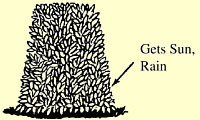Pat Cooke, Master Gardener
As I write this, the temperature outside is in the low 70’s. We had frost this morning. It is no wonder that gardeners are scratching their heads wondering when they can safely trim or prune their landscape plants. Too soon, and the newly stimulated growth will be damaged by the cold. But if your cold damaged shrubs are already sending out new growth, you might as well begin trimming dead stems. Scratch the surface of the stem. If you see green, that stem is alive.

For woody ornamentals like azaleas or camellias, trim them as soon as they finish blooming. The blooms for next year will begin to form in late summer. Trimming too late in the season takes off next years showy flowers. Wait with gardenias. They haven’t bloomed yet this year.
Thinning out a dense shrub keeps it healthier. Sunlight can reach past the outer leaves, and good air flow allows the foliage to dry out between irrigation events. Damp foliage is a magnet for pest organisms. Put aside the hedge trimmer, don your garden gloves and use a sharp pair of clippers or loppers. Take off crossing (rubbing branches). Then step back and decide what other branches need to be trimmed. Wherever you cut it, a live trimmed branch will flush out with new growth.
If you want a formal, shaped hedge, be sure to trim plants so that the tops are wider than the bottom (see below). The lower leaves need sunlight too. A dense outer layer of leaves will eventually result in die-back in the interior of a shrub, so shape but thin as well.

If you aren’t sure what plants you have, take a close-up picture and send it to the UF/IFAS Extension office, Hernando County for an ID. The email address for the Master Gardener plant clinic desk is masterg@hernandocounty.us.
 0
0
